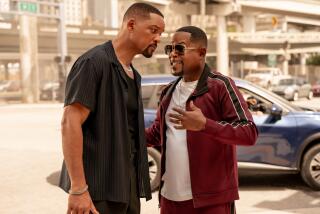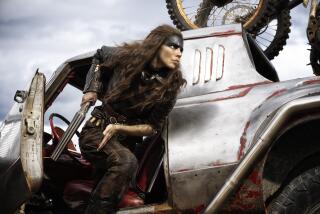Review: ‘Mad Max’ kicks a post-apocalyptic extravaganza into overdrive
- Share via
“Mad Max: Fury Road” will leave you speechless, which couldn’t be more appropriate. Words are not really the point when it comes to dealing with this barn-burner of a post-apocalyptic extravaganza in which sizzling, unsettling images are the order of the day.
As directed by George Miller in a reanimation of the “Mad Max/Road Warrior” franchise he began in 1979, “Fury Road” is so action intensive and non-dialogue dependent that it began not with a proper script but with about 3,500 storyboard panels detailing an endless string of adrenalized events in a bleak and savage future world where water is king but chaos rules.
Costarring the protean Tom Hardy (re-creating the Max Rockatansky character originated by Mel Gibson) and a shaved-headed Charlize Theron, “Fury Road” is essentially one nonstop, two-hour chase with the bad guys in constant hot and heavy pursuit of the few good folks left in this scary, derelict and deviant world. If you think that doesn’t sound involving, you haven’t been paying attention.
The idea, explains Miller (credited as screenwriter with comic artist Brendan McCarthy and dramaturg Nico Lathouris) was inspired by “Alfred Hitchcock’s notion about making films that can be watched anywhere in the world without subtitles. ... They take you to a place outside yourself, and you come out the other end having had an experience.” Just so.
Working with Oscar-winning cinematographer John Seale (who came out of retirement to do this), Miller decided that as much of “Fury Road” as possible would be shot without digital effects. With the help of new tools like the Edge Arm system, a camera crane that extends more than 20 feet and handles a full range of motion, Miller kept multiple physical stunts running at the same time (Guy Norris was the accomplished second unit director and stunt coordinator) and ended up shooting an estimated 480 hours of adrenalized footage.
Dealing with all of this was Miller’s longtime collaborator, nonpareil editor Margaret Sixel, who manages the neat trick of neither lingering too long on any shot or rushing through the inevitably hectic proceedings. Her cutting shows you just what you want to see exactly when you want to see it, and it’s hard to imagine “Fury Road” without her expert guidance.
The film’s other heroes are production designer Colin Gibson and his team, who came up with an entire derelict and grotesque civilization (with visible tumors and growths chalked up to a poisoned environment) that has been created with unparalleled imagination, specificity and craziness. Few films immerse us as completely in their universe as “Fury Road” does, to often disconcerting effect.
The center of “Fury Road’s” world is the Citadel, a massive fortress built around a complex system for pumping scarce water out of the ground, distributed on a random basis to hordes of the dispossessed who cluster around like the masses in a Sebastian Salgado gold-mining photograph.
Running this particular show is the aging but all-evil all-the-time warlord Immortan Joe (Hugh Keays-Byrne, the villain in the original “Mad Max”). With his face only partly visible behind a disturbing, intimidating mask, Immortan Joe has created an entire mythology around himself and his psychotic army of War Boys, who dream of going to an eternal reward in Valhalla if they die in glorious combat in his service.
As played by Hardy, Max is a man of very few words, most of them uttered in an initial voice-over. “My name is Max, my world is fire and blood,” he says, telling us as well that he is “someone who flees from both the living and the dead,” haunted by images of the daughter he could not save as he tries to survive in this most bestial world.
“Fury Road” begins with Max imprisoned and enslaved at the Citadel. An overzealous War Boy named Nux (an effective Nicholas Hoult) uses Max as what’s called a blood bag, a continuous human blood transfusion system that enables the contaminated Nux to stay alive.
One of Immortan Joe’s top lieutenants at the Citadel is Imperator Furiosa (Theron), a sullen, ferocious individual with an elaborate prosthetic arm. Furiosa kicks the plot into gear by ostensibly heading out for supplies in a War Rig, a massive 78-foot 18-wheel truck.
In reality, Furiosa, fed up with life under the Immortan, is making a break for it and taking with her the leader’s prize possessions. Those would be his five wives, including Toast the Knowing (Zoe Kravitz), the Splendid Angharad (Rosie Huntington-Whiteley) and Capable (Riley Keough), all clothed in diaphanous white cloth like the pulp-fiction archetypes they are.
The Immortan, of course, is determined to get his wives back, and he calls on allies with names like the People Eater and the Bullet Farmer. Which is how a staggeringly eclectic flotilla of motorized attack vehicles join in the chase, including one carrying the Doof Warrior (Australian singer-songwriter iOTA), a red-clad fury who plays a double-necked electric guitar (which doubles as a flame thrower) to inspire the troops.
Set like a human hood ornament on the front of Nux’s vehicle, Max is thrust into the heart of the action whether he wants to be or not. It is not long before things transpire to make him and Furiosa wary allies, and the chase goes into overdrive.
Hardy, the villainous Bane in “The Dark Knight Rises,” is especially good at these feral roles, and Theron is his match here. The real star of “Mad Max: Fury Road,” however, is filmmaker Miller, who dreamed the mighty dream that is this film for more than a decade before being able to bring it to life. It has been worth the wait.
------------
‘Mad Max: Fury Road’
MPAA rating: R, for intense violence and disturbing images
Running time: 2 hours
Playing: In general release
More to Read
Only good movies
Get the Indie Focus newsletter, Mark Olsen's weekly guide to the world of cinema.
You may occasionally receive promotional content from the Los Angeles Times.











